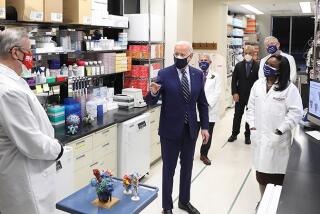Law Catalyzes Research but May Face Dilution
- Share via
The automated DNA sequencer could turn out more than a draft of the human genetic code. It could produce the first significant legal test of Washington’s rights under a 2-decade-old law designed to speed technological change by pushing federally funded research into private hands.
The 1980 law, known as the Bayh-Dole Act, was approved at a time when America seemed to be losing its high-tech edge to Japan and other rivals. The law sought to do something about the problem by allowing scientists to patent discoveries made with taxpayer money and, along with their universities, license the findings to companies for use in developing commercial products.
By many measures, it has been a wild success. It produced the Internet search engine Lycos, the cancer drug cisplatin and the DNA copying technique at the root of everything from genetic sequencing to the O.J. Simpson case. It is widely credited with having created the biotech industry. And it turned the nation’s universities into patent factories.
Before the law’s passage, American schools produced about 250 patents a year, many of which went nowhere. In 1998 they churned out more than 4,800, according to the Assn. of University Technology Managers.
But the Bayh-Dole Act has also produced some troubling side effects. Medicare and other government programs are forced to pay high prices for drugs whose development the government underwrote, and government-financed researchers spend more time chasing private business deals than scientific knowledge.
“In our greed and anxiety to raise money, there’s a danger of pushing universities into being trade schools, and it bothers the hell out of me,” said Marvin Goldberger, Caltech’s president in the mid-1980s, when the automated DNA sequencer was invented. “I could be a voice in the wilderness and living in a dream world, but I believe universities . . . have a higher calling.”
Although the law was designed to get discoveries made with federally funded research into the marketplace, it left Washington with some rights. The government is entitled to a discount on its own purchases, it can reclaim research that is not being quickly commercialized and it can take control of an invention for health and safety purposes.
In cases of violations of the law, the government can take over the patents of the inventions involved.
Washington has occasionally tested its powers over federally funded research--with mixed results. In 1991, the National Institutes of Health challenged the patent for the AIDS drug AZT on the ground that it had helped develop the drug but was now being forced to pay the manufacturer thousands of dollars a year to cover the costs of AIDS patients.
NIH granted a second company the right to make a cheaper, generic version of the drug and set up a system for setting “reasonable prices” on drugs emerging from federally funded research. The effort collapsed when the original manufacturer sued for patent infringement and won.
More recently, investigators have tried to get universities to comply with requirements that they notify the government of inventions made with federal funds.
A 1994 investigation found that the Scripps Research Institute in La Jolla notified the government in only about half the cases where taxpayer money was involved. Last year, a preliminary report by the Department of Health and Human Services concluded that universities nationwide failed to report more than 1 in 5 NIH-funded inventions.
Otherwise, the government has done little to enforce its rights to federally funded inventions.
At least until now.
If investigators pursue the sequencer issue to its end--and they show every sign of planning to--the case would represent a major test of the law and could result in the first significant readjustment of the balance between private and public interests in federally funded research since the Bayh-Dole Act was passed two decades ago.
More to Read
Sign up for Essential California
The most important California stories and recommendations in your inbox every morning.
You may occasionally receive promotional content from the Los Angeles Times.













